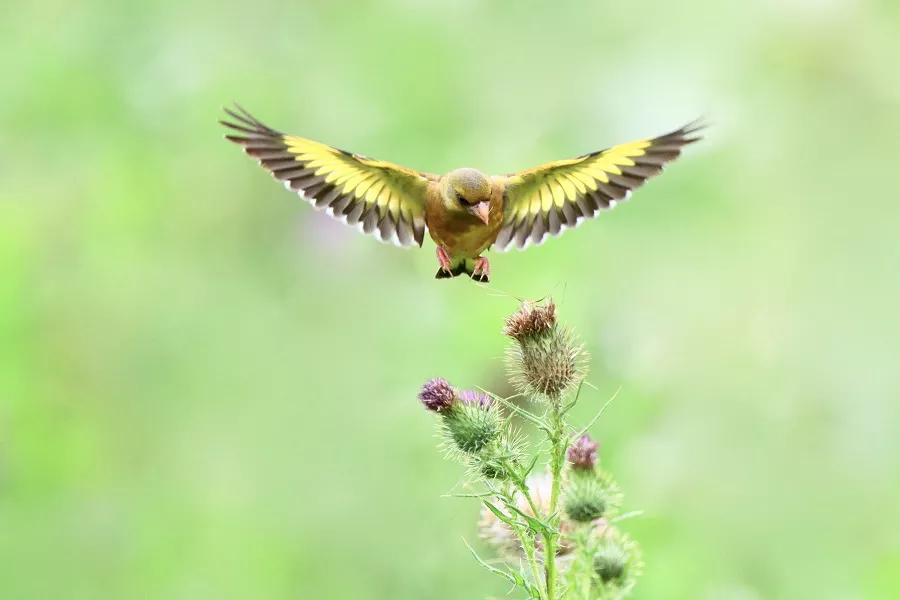The charming and vibrant goldfinches, with their distinctive plumage and melodious songs, have captured the hearts of bird enthusiasts and casual observers alike. These small songbirds belong to the finch family and are renowned for their bright yellow coats and intricate vocalizations. A prevalent curiosity surrounding goldfinches pertains to their habitats and distribution patterns. In this article, we delve into the world of goldfinches, uncovering the diverse landscapes they inhabit and shedding light on the factors influencing their geographic distribution.
The Ecological Niche of Goldfinches
Goldfinches, scientifically known as Spinus tristis, exhibit a broad geographic distribution across North America, from the southern parts of Canada to the United States, Mexico, and Central America. These birds thrive in a wide range of ecosystems, displaying remarkable adaptability to various habitats such as open woodlands, grasslands, meadows, gardens, and urban environments. Their ability to inhabit such diverse locales highlights their ecological flexibility, an important trait that has contributed to their widespread presence.
Woodlands and Forest Edges: Preferred Homes of Goldfinches
One of the favored habitats of goldfinches includes open woodlands and forest edges. These birds are often found perched atop branches, emitting their delightful twittering calls and flitting about in search of food. Woodlands provide them with the perfect balance of shelter and food sources, making them well-suited for survival. The availability of seeds from trees like conifers and deciduous species contributes significantly to their diet, as goldfinches are primarily granivorous, relying heavily on seeds for sustenance.
Grasslands and Meadows: A Bounty of Seeds
Goldfinches are particularly drawn to grasslands and meadows due to the abundant supply of seeds from various plant species. These habitats offer a rich tapestry of vegetation that produces the seeds these birds find irresistible. Their dexterity in clinging to swaying grass stems while feeding showcases their remarkable agility. During the breeding season, these open landscapes provide ample nesting sites, as goldfinches construct intricate cup-shaped nests among the tall grasses.
See Also: What do Goldfinches eat? (What You Need To Know)
Human-Altered Landscapes: Goldfinches in Urban Environments
The adaptability of goldfinches is strikingly evident in their presence within urban environments. Parks, gardens, and suburban areas offer an array of flowering plants and cultivated vegetation that serve as potential food sources. Goldfinches are attracted to gardens with nectar-rich flowers and plants that produce small seeds. Their bright plumage adds a touch of color to cityscapes, often turning urban gardens into bustling birdwatching hotspots.
Migration Patterns and Seasonal Movements
Understanding the migration patterns and seasonal movements of goldfinches contributes to unraveling their distribution. Goldfinches are classified as short-distance migrants, with many populations engaging in altitudinal migrations. This means they move to higher elevations during the breeding season and descend to lower altitudes during the colder months. These migrations are often triggered by changes in food availability and temperature. Their movement dynamics contribute to their presence in a wide range of habitats throughout the year.
See Also: When Do Goldfinches Migrate? (Revealed!)
Factors Influencing Distribution
Several factors influence the distribution of goldfinches across different regions. One of the most prominent factors is food availability. Goldfinches have a specialized diet consisting primarily of seeds from a variety of plant species. Therefore, areas with abundant seed-producing plants are more likely to attract and sustain goldfinch populations.
Climate also plays a crucial role in their distribution. Goldfinches are well adapted to temperate climates and are commonly found in regions with mild to cool temperatures. Harsh winters or extreme heat can limit their presence in certain areas. As such, their distribution tends to align with climatic conditions that suit their preferred habitats and food sources.
Conservation and Habitat Management
Conservation efforts aimed at preserving goldfinch populations focus on protecting their habitats and ensuring the availability of suitable food sources. Afforestation projects, reforestation initiatives, and the maintenance of grasslands and meadows are all important for their survival. Additionally, creating bird-friendly urban spaces by planting nectar-rich flowers and providing bird feeders can support goldfinch populations in human-altered landscapes.
Conclusion
Goldfinches, with their vibrant plumage and enchanting songs, have found their homes in a diverse array of habitats across North America. From woodlands and meadows to urban gardens, these adaptable birds have managed to thrive in various environments due to their specialized diets and migratory behaviors. Understanding the factors that influence their distribution is essential for their conservation, ensuring that future generations can continue to marvel at the beauty and charm of these delightful songbirds.


 Facebook
Facebook  Instagram
Instagram  Youtube
Youtube 